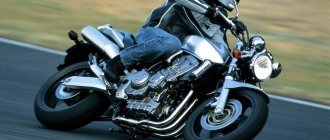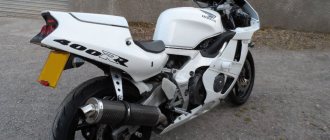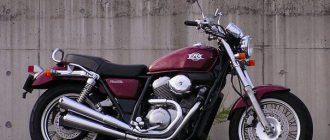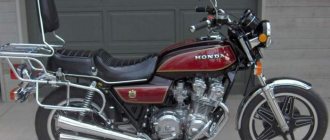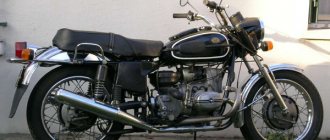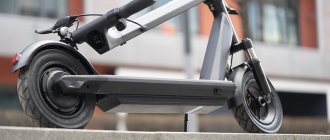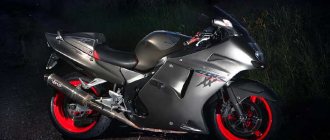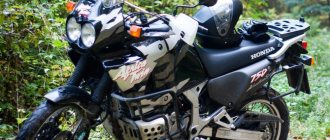Model class : road.
Years of production/sales: 2000-2006
The BMW R1150R was first introduced in 2000 as a replacement for the BMW R1100R. In addition to visual changes (wheels, shape of the front fender, seat and gas tank), the model receives a number of technical improvements. Firstly, there is a new 1130 cc engine. cm, producing more power and torque (85 hp, 98 Nm). Secondly, the integral (combined) ABS system (or 2nd generation ABS), which works more efficiently, but is technically more complex and less reliable compared to ABS on the BMW R1100R. Thirdly, a more powerful braking system (the diameter of the front brake discs has been increased from 305 mm to 320 mm). Fourthly, the size of the wheels (120/70 ZR 17 - front, 170/60-ZR 17 - rear), which were taken from the sports version of the BMW R1100S. Fifthly, a 6-speed gearbox, instead of the traditional 5-speed gearbox for the 1100 series (except for the R1100S), and a hydraulic clutch drive, which solves the problem of cable breakage on 1100 series models.
Main modifications of the BMW R1150R:
- BMW R1150R – regular version.
- BMW R1150R Rockster – produced from 2003 to the end of 2005. It differs in appearance (frame, valve covers and fork are blue, except for 2005 models; electronic clock, white tachometer, striped coloring of the motorcycle, double headlight from R1150GS) and in technical parts (automatically switched off turn signals, two spark plugs per cylinder, 87 hp power, closely spaced gearbox ratios, rear tire size - 180/55 ZR 17).
Otherwise, the BMW R1150R model has a classic layout common to all flagship BMW motorcycles - a 2-cylinder air-oil-cooled fuel-injected boxer engine, a frame with the engine as a load-bearing structural element, proprietary Telelever and Paralever suspensions, powerful Brembo disc brakes with ABS as an option , standard heated grips and traditional cardan drive to the rear wheel.
The BMW R1150R model was produced until the end of 2005, and since 2006 it gave way to the updated version of the BMW R1200R.
The “younger brother” of the BMW R1150R model is the BMW R850R (2003-2005).
Specifications
Technical characteristics of BMW R1150R:
| Model | BMW R1150R |
| Motorcycle type | road |
| Year of issue | 2000-2006 |
| Frame | composite, aluminum front part, engine - load-bearing element |
| engine's type | 2-cylinder 4-stroke boxer (Boxer) |
| Working volume | 1130 cc |
| Bore x Stroke | 101x70.5 mm |
| Compression ratio | 10.3:1 |
| Cooling | air-oil |
| Number of valves | 4 valves per cylinder, 1 camshaft per cylinder head |
| Fuel supply system | Bosch Motronic MA 2.4 injector |
| Ignition type | electronic |
| Maximum power | 85 hp at 6750 rpm (87 hp - Rockster version) |
| Maximum torque | 98 Nm at 5250 rpm |
| Transmission | 6-speed |
| type of drive | cardan |
| Front tire size | 120/70 ZR 17 |
| Rear tire size | 170/60-ZR 17 (180/55 ZR 17 - Rockster version) |
| Front brakes | 2 discs, 320 mm, 4-piston calipers (optional ABS 2nd generation) |
| Rear brakes | 1 disc, 276 mm, 2-piston caliper (optional ABS 2nd generation) |
| Front suspension | BMW Telelever (preload adjustment), stroke - 120 mm |
| Rear suspension | pendulum BMW Paralever (preload and rebound adjustment), stroke - 135 mm |
| Overall dimensions (LxWxH) | 2170 x 970 (with mirrors) x 1220 mm |
| Seat height | 800 mm |
| Gas tank capacity | 20.4 l |
| Maximum speed | 197 km/h |
| Acceleration to 100 km/h (0-100) | 4.23 sec |
| Motorcycle weight (curb) | 238 kg |
BMW R1150R Rockster: Test drive from Motodrive magazine
When I first sat on the BMW R1150R Rockster, I clearly imagined its habitat - smooth European roads, intricately winding through a pastoral landscape, a cool but sunny day and the obligatory mountains on the horizon.
No matter how many names they call this model: here you have a streetfighter, a naked, and a sports tourer, but everything is past, but this Bavarian is a roadster from the “brains” to the crankshaft bearings.
It was a good day for the test drive - sunny, dry, but not hot. Having escaped the city crowd outside the city, the BMW owner and I exchanged motorcycles. Before riding the “unknown animal”, I had to make a roundabout walk - useful, you know...
The basis of this motorcycle is an injection two-cylinder boxer with a volume of 1130 cm3, a “boxer”, as they say abroad. In general, I have always been interested in the efficiency of heat removal from engines of this series, because the cooling here is air-oil, the fins are modest, and 85 hp. – this is a lot. What if you get stuck in traffic on a hot summer day? After all, with such ground clearance there is nothing to do on the curbs, and because of the splayed cylinders, you can’t really squeeze between the cars. “Come on, Herr Serge, look, you’re not testing a scooter,” my conscience reproached me with a German accent, “you should have driven it into the forest to get the full experience!” Having hidden it (conscience) deeper, I continued to study the “patient”.
There is no frame as such here - its functions are performed by the engine itself and two satellite subframes. The suspension is traditional: telelever at the front and paralever at the rear, and the shock absorbers have adjustable spring preload and rebound damping. Of course, there are still some tweaks to be made, but I can't imagine an R1150R owner tweaking the settings every day, trying to beat his own lap record on the 'ring.
The controls are standard... for BMW. Unlike the K1200RS, which was test driven two months earlier, only the cruise control toggle switch on the left console is missing. Everything else is one to one. The dashboard does not have a modern design, but it is very readable. If we take into account the Bavarian origin of the motorcycle and the Germans’ desire to embed a computer even in a ballpoint pen, then the set of information provided can be called rather poor. For example, there was nothing stopping you from installing a full-fledged fuel gauge here, and an engine temperature indicator would not be at all superfluous (not to mention the gear indicator and other interesting, but not particularly necessary, “gadgets”).
The traditional round is completed, I sit in the saddle, turn the key in the ignition and press the starter button, located in the “proprietary” (well, everything is not like people!) place. The dry sound of the starter grew into a rich hum that burst out of the tuning Akrapovic. The sound is not loud, but pleasant. Having accelerated in place, I really felt that the boxer engine was persistently trying to turn the motorcycle around itself - a peculiar sensation, I must say. Having squeezed the lever of the moderately tight hydraulic clutch and put it in first gear, I drove out onto the highway. But the landing is okay: comfortable, with a slight tilt forward... The steering wheel, however, is also tuning - the original one is lower and moved further back. Thanks to the low seat height of 770 mm, even short riders will be comfortable on this “Bavarian”.
The peculiarity of the engine layout appeared during the first active acceleration. At the moment of switching, the motorcycle first swung sharply to the left, and then to the right - perhaps it’s not for nothing that it’s called a “rockster.” Because of this effect, it is very difficult (and actually damn scary) to drive dynamically if you are not used to it. To reduce the jerk, you must either shift “up” without a clutch, fortunately, the gearbox welcomes this, or work very smoothly with the gas, but then goodbye dynamics.
The sample we tested had a completely unnecessary tuning windshield, since there is no standard wind protection here (well, why not call that blotch that doesn’t even protrude above the dashboard “windshield”?). Thanks to this, the comfortable speed on the highway was 150-160 km/h, and even at “200” there was no obvious discomfort.
The stability dictated by the 238 kilograms of curb weight creates the feeling of flying astride a cast iron iron, which, in addition, is filled with coal in the amount necessary for a trip across the Atlantic. Neither side winds nor oncoming cars deviate the motorcycle from a given trajectory, but the engine continually tries to spin the motorcycle around itself. However, with increasing speed, this effect becomes dulled due to the fact that the wheels themselves become gyroscopes and resist any change in the plane of rotation.
It was here, on the track, that the engine's potential was revealed. Perhaps this is one of the most flexible power units, second only to the “in-line” one on the K1200RS. In the highest, sixth gear, you can drive 40 km/h, and from 50 you can confidently accelerate, without jerks in the transmission. The engine begins to pull already from 2 thousand revolutions, but at four to five thousand, when the phlegmatic hum begins to turn into the roar of a bull that has pinched its most important organ, small high-frequency vibrations arise. They “blur” the image in the mirrors and noticeably tickle your feet even through the rubber pads and soles of the motorcycle boots. With further increase in speed they do not disappear, but become less unpleasant.
Once out on the highway, you can forget about the stiff but clearly functioning gearbox - the excellent traction characteristics of the engine eliminate the need to constantly “oil” the gearbox foot. Yes, it does not amaze with cosmic dynamics, but 85 hp. and 100 Nm will be a good help on long overtaking, and the adequate nature of their increase will reduce the likelihood of excesses on slippery surfaces. On a deserted section of the highway, it became possible to check the dynamics of deceleration, without fear that a Georgian driver walking in the wake of a “penny” would park “in the back” and ask a philosophical question: “Daragoy, why are you braking so fast, right?” The brake system of the R1150R, traditionally for BMW, is equipped with an electronic booster and ABS, and thanks to reinforced hoses, when you press the lever there is no feeling that you are pressing a button. To put it in familiar language: there is good feedback, which was absent, as a concept, on the recent K1200RS. Performance is fantastic. But this only applies to the front brake. The rear one is moderately indistinct.
Soon the first city traffic lights loomed ahead and from the “cruising” 140-160 I had to drop to the “traffic” 40-60 km/h. At low speeds, the Bavarian tends to straighten its trajectories. Strange thing: the often mentioned K 1200 RS suffered from oversteer, but this one exhibits understeer. It is worth noting that it is easy to get used to this - after two hours I no longer understood what had previously annoyed me so much.
Unfortunately (or fortunately?), it was not possible to find a decent traffic jam, about three hundred to five hundred meters long, and at a standard city pace the huge boxer didn’t even think about overheating (maybe it just didn’t show it?). However, he showed himself in other ways. Thanks to its considerable width, which was increased by the protective arches, it was difficult to squeeze between the cars. But if you press to the side of the road and pass the right cylinder over the curb, then the “geometric passability” of congestion increases by one and a half times.
In such conditions I appreciated the mirrors. I would characterize the visibility in them as necessary and sufficient, but the best thing is that they almost do not extend beyond the width of the steering wheel, and therefore do not tend to cling to other vehicles.
The suspensions, tuned for a comfortable ride, did not give in to bad asphalt and stoically endured speed bumps and tram rails, providing the motorcycle with a smooth ride. But in significant slopes, the handling of unevenness was far from ideal - after all, the telelever lever and massive pipes significantly increase the unsprung masses. But this device is not for the track, so what can we find fault with... Driving on average quality asphalt at 120-130 km/h is quite comfortable - the suspension manages to absorb most of the defects in the road surface, and what was missed is effectively dampened by the soft seat.
The head light of this model is as unique as everything else: the low beam, for which the lens headlight is responsible, is frankly weak, but is compensated by the powerful high beam (although you can’t tell by the size of the headlight reflector).
The unusual “look” of the optics fully reflects the character of the motorcycle: a little eccentric, crazy and spontaneous, but with a spice, in which (somewhere deep) one can discern the innate German stiffness and pedantry - that’s exactly what it is, the BMW R 1150 R.
Go to the BMW R1150R
BMW R1150R: Comparative test drive with BMW R1100S
Two bombs
text from Motorreview No. 1, 2005:
Vladimir Zdorov,
photo:
Dmitry IvaikinBMW R1150R Rockster: 1130 cm3, 85 hp, 200 km/h, € 14,600
BMW R1100S: 1085 cm3, 98 hp, 226 km/h, € 14,600
Boxer motorcycles can be dynamic and controllable like a sportbike - the Bavarians have proven this fact a long time ago. I had to check this on the example of the most prominent representatives of this tribe.
The test started out rather unusually. Without even touching any of the motorcycles in front of me, I already had to make a choice, which, as usual, is the most painful and lengthy. The fact is that I was familiar with these two models exclusively on paper. Usually, in comparative tests, already before the first touch of the throttle, I more or less imagine the features of a particular motorcycle model, since I have ridden it more than once before. Here, a quick scan of my own data bank about the BMW motorcycles I have ever tested for specific two models gave my “internal” screen a laconic phrase - no riding experience... The chain of reasoning for the subsequent choice looked something like this: “so, the R1100S is a sportbike , and I don’t get off them day and night anyway, but the R1150R is BMW’s modern vision of a naked class motorcycle, and this is more interesting...” A direct landing means better control of my beloved wheelie (please note that this is not the name of a stray and handsome young American in need of my endless care, but just riding on the rear wheel!..), a brutal appearance (according to BMW concepts, of course) will scare away numerous motorists. In short, a real Road Hooligan! The choice is made!
We will rock... ster! I’m trying to place my not-so-short limbs, but it’s not too bad. In terms of space provided for tall pilots, BMW (and this applies to both models) has one of the best indicators among its competitors. The sound from a running engine is not much reminiscent of a motorcycle - for example, the muffled hiss of a car engine strangled to the strictest European standards... In our harsh realities, this is not so much bad from the point of view of show-off and pathos (although these are far from the most recent factors...), but from the point of view of From a safety point of view, the homicidal maniacs in four-wheeled iron boxes must know you're coming! Despite the opposed arrangement of the cylinders, absolutely nothing interferes with my “inch” 46, trampled in work by both left and right feet. The classic tidy with completely non-motorcycle tachometer values is perfectly readable, the “picture” in the mirrors is not blocked by anything, and the vibration on them only exists at idle, and even then in a heavily damped form. In the ergonomics discipline, the Bavarians earned a solid “A”. The only thing I categorically do not accept is the complicated scheme for turning on the turn signals. This sacrament is controlled by as many as three buttons! The left one is responsible for left (good thing, not right) turns, the right one, respectively, for right ones, plus there is also a button to turn off the “flashing lights”! By God - too much! True, so that the “5” for ergonomics is not reduced to “4”, the Germans include heated handlebars as a basic feature on motorcycles sold in Russia. The near-zero-effort clutch and hydraulic drive also contribute significantly to the fundamental and thorough approach of the designers of the motorcycle pilot's living environment. The purpose of which can be seen very clearly right from the wide and comfortable seat (which also has several height adjustments!) - this is total comfort.
The company has clearly developed its own vision and concept of motorcycle values. The “bauble”, already familiar from endurance tests of the BMW R1200 CL, in which first gear does not engage when the clutch is fully depressed, has appeared here too. It’s okay - it’s just a feature that you quickly get used to and after literally half an hour of driving you completely forget about it... At the same time, the process of changing gears itself is extremely easy and minimal: by moving the shift lever... The process of mastering the motorcycle was interrupted by a call from our photographer, the essence the conversation boiled down to a rather laconic phrase: “What kind of swamp goblin are you still not there? I’ve been waiting for you for half an hour, all hungry and cold, etc. and so on.".
“You” are me and Vladimir Tchaikovsky, director of the BMW motorcycle service department, who is primarily interesting to me because during the season he has been using our today’s counterpart - the BMW R1100S, and has already covered quite a decent mileage on it, and his opinion about the model seems very valuable. I’ve known Vladimir for about 10 years. And before, his style of piloting motorcycles in city traffic at very serious speeds aroused my respect. Yes, as expected, the passing years and the weight and dimensions of his R1100S have not changed or slowed down the speed of piercing the urban jungle.
At some point, I was almost behind, and what saved me was a completely dead traffic jam, where it’s not like driving between cars on a scooter, but you can’t even get into dystrophy - it will instantly smear along the sides. However, this circumstance did not bother my leader in any way. Attacking a huge curb at a right angle (the ground clearance of the R1100S is wow; he would try to do the same on any other modern sportbike!), he rushed off to scare passers-by on the sidewalk. So much for a respectable BMW pilot! I had to do the same manipulation...
Very soon the Rockster weaned me from twisting the tachometer like a sportbike in vain. Peak torque occurs at just above 5,000 rpm. So it just doesn't make much sense. Here, for fast and dynamic movement, you should switch to 6000, in a word, a real... BMW car, say, some BMW 530. Very similar. Having caused concern at first, sticking out widely on the sides like ears on the shaved skull of a first-year cadet, the cylinders during “tight” maneuvering turned out to be a real deterrent, but rather a psychological one. The situation, as Vladimir explained to me, is very simple here, the steering wheel passes - the cylinders will definitely pass... To be honest, after two hours of driving I completely forgot about their existence, but... There is this “but” from which, alas, no one not insured. Even with a minor fall, they are prime candidates for injury. The company itself offers a lot of factory tuning to protect them. There is also the German Tourtech, which also specializes in the company’s products; in general, I would put the crash bars here right after the purchase. I won’t write about the fact that as soon as you start, the large mass of the motorcycle literally dissolves and you stop noticing it. In this case, this is not entirely true. That is, 229 kg of curb weight does not turn into 163 kg of some GSF600, which, however, also has its positive side. Yes, you can’t change the trajectory with the ease of a “six hundred” on an R1150R. But even on the most broken asphalt surface, the motorcycle strictly follows the given trajectory, instilling the feeling that some external factors (well, unless, of course, it’s some KamAZ) can practically not affect the course of its movement. Although the matter, of course, is not only in the mass, but also in the excellent working suspensions of the motorcycle. Telelever on the front and Paralever on the back. Moreover, one of the features of the front suspension, for example, is such a positive point as the complete absence of “dive”, even during emergency braking. And Paralever does not allow the motorcycle to “stand up” at all, even at maximum acceleration. All this improves control accuracy, but takes some time to get used to. On the first “twist” from the Moscow Ring Road, I “climbed” onto the slider, while there was not a shadow of an objection in Rockster’s behavior. The bike remained very stable and predictable. Considering that there is no frame as such (its functions are carried out by the engine), this is very worthy. From here I conclude that the BMW R1200 GS (oh, we couldn’t get to it, our “chief” really liked it), it’s also quite possible to put it “on your knee.” There’s no mention of the R1000S – with its seating position and positioning of the footpegs it will be even easier.
Having wasted half a day on the eternal whims of our photographer, the weather was not the same, the motorcycles were somehow not going well, everything was bad, our pants were tight, etc., we finally finished the photo shoot. The weather forecast office's optimistic announcement of a sunny, clear day had initially instilled in my soul the absolute certainty of rain to come, and judging by the darkening skies, it was only a matter of time. I still had a couple of unanswered questions regarding Rockster, so I had to hurry. The first is the maximum speed and behavior of the motorcycle at it. Here the picture is as follows: 210 km/h on the speedometer, oddly enough, is quite tolerable, with the wind blowing and the stability of the tram. Everything is clear here. It's time to do the wheelie... After torturing the motorcycle pretty much, I finally forced it to go in reverse from second gear (using the clutch, of course), but this exercise, despite the serious torque, is given to the Rockster with great difficulty... And it's "dry" “The car-type clutch, spreading a burnt smell, clearly made it clear that you should calm down... Looking ahead a little, I’ll note that the R1100S is even worse with this - no “second”, only first gear. Although, given the target group of owners and future buyers of these thoroughbred two-wheeled Bavarian “horses,” it is at least absurd to seriously discuss such nuances as shortcomings, these are rather just observations.
Twin Brother It was time to swap motorcycles, and already in the saddle of the R1100S, I was very seriously surprised... by their almost complete similarity. Yes, the seating position, with a barely pronounced forward tilt and with the footpegs slightly set back, gives off a certain spirit of sportiness, but here it is somewhat pretentious. I would say that this motorcycle is all about style. Here, they say, I’m riding a sportbike. The engine has 98 German traction horses for nothing, which is more powerful by as much as 13 hp. on paper, in practice it is only a barely perceptible fraction of a second faster than the 85-horsepower R1150R engine. And according to subjective sensations, it is completely indistinguishable. And only the speedometer needle, which quite briskly crosses the 220 km/h mark, still speaks of the difference in power. The global difference lies in the surprisingly high degree of wind protection of the R1100S. There is no wind pressure felt at all, which, coupled with the silently running motor, even somewhat dulls the feeling of real speed. It seems that you are driving some measly 60 km/h, but meanwhile the speedometer already shows 120 km/h. All-consuming comfort.
The readability of the instruments is also okay here, and the mirrors perhaps provide a slightly larger viewing area. However, all these are nuances. In general, I repeat once again, these two models, despite such serious external differences, are very similar. At some point, the rain, naturally, got really angry, and, oddly enough, I was very happy about it, because both models are already “basically” equipped with ABS and brake servos, the performance of which I intentionally left for last. Fortunately, I was already very familiar with its features from the same R1200 CL. The fact is that brakes with servo drives, especially at first, may seem overly harsh and uninformative. And in order to objectively evaluate their work, it takes some time. You need to, as they say, “roll in.” In general, their work again evoked some automotive associations in me. The deceleration process is simply exemplary, and the efficiency is such that without ABS they would be simply dangerous. All this is not to say that, say, in some comparative braking from 100 km/h, the R1100S will easily outperform, for example, the GSX-R1000. No, of course, at that same speed I’ll probably stop noticeably faster at that same speed, and the huge plus here is this: put a beginner on an R1000S or a Rockster, and from the same 100 km/h it will show the same braking performance the same way as a highly experienced expert... Complete safety, which was illustrated right before my eyes by the restless Tchaikovsky, who completely upset the motorcycle right on the “plastic” dividing strip. In the rain, the ABS did its job properly, and the device maintained strictly linear movement. I also noted the high efficiency of the rear brake, which can and should be used on BMW motorcycles.
Verdict Usually during tests I have to refuel the equipment, but here the large gas tanks (20.4 and 18 liters) of both models allowed me to conduct a full test (more than 200 km) without stopping at a gas station. What remained beyond my attention were such traditional BMW values as the driveshaft and the feeling of seating the passenger. However, they are well known. I can’t say that I was amazed by the level of dynamics of both devices. But the level of comfort and driving safety provided here is, rather, at the automobile level. As you already understand, the company has its own ideas about motorcycle values. I really liked Rockster. Is it a little more honest than the R11000S, although I’m sure many will disagree with me, and I’ll even accept their claims. In my own assessment of motorcycle values, the ability to ride in reverse from second gear is much more important than effective wind protection.
